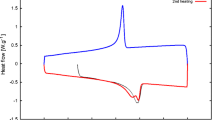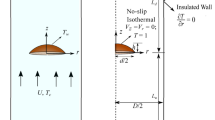Abstract
A numerical model for bottle forming simulation is proposed. It is based upon the Particle Finite Element Method (PFEM) and is developed for the simulation of bottles characterized by rotational symmetry. The PFEM strategy is adapted to suit the problem of interest. Axisymmetric version of the formulation is developed and a modified contact algorithm is applied. This results in a method characterized by excellent computational efficiency and volume conservation characteristics. The model is validated. An example modelling the final blow process is solved. Bottle wall thickness is estimated and the mass conservation of the method is analysed.











Similar content being viewed by others
Notes
Note that \( \bar{\mathbf{v }} = \bar{\mathbf{v }} _a=[ \bar{\mathbf{v }} _r (r,z)\,\,\,\, \bar{\mathbf{v }} (r,z)]^T\) and \( \bar{\mathbf{p }} = \bar{\mathbf{p }} _a= \bar{\mathbf{p }} _a(r,z)\) are the discrete counterparts \( \mathbf v _a\) and \(p_a\) respectively. We shall omit the a index in what follows.
The maximum velocity can be also estimated by noticing that the volume of the paraboloid defined by the velocity profile must be equal to the area of the inlet multiplied by the inlet velocity. Taking into account the no-slip condition applied at the area where the constant non-zero flux is applied is \(A_\mathrm{flux}=\pi (R-h)^2\), where h is the mesh size. Thus: \(V_\mathrm{paraboloiod}=v_{\max }\frac{1}{2}\pi R^2=\pi (R-h)^2 v_i\). Thus (taking \(R=0.1\), \(h=0.0025\)) we obtain: \(v_{\max }\approx 0.19\) m/s.
References
Pfaender HG (2012) Schott guide to glass. Springer Science and Business Media, Berlin
Miller GL, Sullivan C (1984) Machine-made glass containers and the end of production for mouth-blown bottles. Hist Archaeol 18/2:83–96
Lerman R (2016) eBottles a history of glass bottle and glass jar manufacturing. https://www.ebottles.com/articles/GlassHistory.htm. Accessed 16 Mar 2016
Cesar de Sa JMA (1986) Numerical modelling of glass forming processes. Eng Comput 3:266–275
Matthew H (2002) Numerical simulation of glass forming and conditioning. J Am Ceram Soc 85(5):1047–1056
Feulvarch E, Moulin N, Saillard P, Lornage T, Bergheau J-M (2005) 3d simulation of glass forming process. J Mater Process Technol 164:1197–1203
Giannopapa CG, Groot J (2011) Modeling the blow-blow forming process in glass container manufacturing: a comparison between computations and experiments. J Fluid Eng 133:1289–1309
Ryzhakov P, Garcia J, Oñate E (2016) Lagrangian finite element model for the 3d simulation of glass forming processes. Comput Struct (submitted)
NoGrid pointsBlow software. http://www.nogrid.com/product/nogrid-points-blow1. Accessed 16 Mar 2016
Idelsohn S, Oñate E, Del Pin F (2004) The particle finite element method: a powerful tool to solve incompressible flows with free-surfaces and breaking waves. Int J Numer Methods Eng 61:964–989
Oñate E, Idelsohn S, Del Pin F, Aubry R (2004) The particle finite element method: an overview. Int J Comput Methods 1:267–307
Ryzhakov P, Oñate E, Rossi R, Idelsohn S (2010) Lagrangian FE methods for coupled problems in fluid mechanics, 2nd edn. CIMNE. Barcelona, Spain
Dadvand P, Rossi R, Oñate E (2010) An object-oriented environment for developing finite element codes for multi-disciplinary applications. Arch Comput Methods Eng 17/3:253–297
Kratos multi-physcis. http://www.cimne.com/kratos/. Accessed 16 Mar 2016
Seward III TP, Vascott T (2005) High temperature glass melt property database for process modeling. Wiley-American Ceramic Society Edition. Westerville, Ohio
Osher SJ, Fedkiw RP (2006) Level set methods and dynamic implicit surfaces. Springer edition, Berlin
Hirt CW, Nichols BD (1981) Volume of fluid (VOF) method for the dynamics of free boundaries. Comput Phys 39:201–225
Tornberg A-K, Engquist B (2000) A finite element based level-set method for multiphase flow applications. Comput Vis Sci 3(1–2):93–101
Delaunay B (1934) Sur la sphere vide. Izvestia Akademii Nauk SSSR, Otdelenie Matematicheskikh i Estestvennykh Nauk 7:793–800
Franci A, Cremonesi M (2016) Critical investigation of the particle finite element method. Part i: volume conservation with remeshing. Comput Particle Mech (CPM), 19/02/2016 (submitted)
Donea J, Huerta A (2003) Finite element method for flow problems. Wiley edition, Hoboken. John Wiley & Sons, Chichester
Zienkiewicz OS, Taylor RL, Nithiarasu P (2009) The finite element method for fluid dynamics. 6th edn, 3 volumes. Elsevier Butterworth-Heinemann edition. Oxford, Kidlington
Brezzi F, Bathe K-J (1990) A discourse on the stability of the mixed finite element formulations. J Comput Methods Appl Mech 22:27–57
Ryzhakov P, Rossi R, Idelsohn S, Oñate E (2010) A monolithic Lagrangian approach for fluid-structure interaction problems. J Comput Mech 46/6:883–899
Yanenko NN (1971) The method of fractional steps. The solution of problems of mathematical physics in several variables. Springer edition, translated from Russian by Cheron T
Chorin AJ (1967) A numerical method for solving incompressible viscous problems. J Comput Phys 2:12–26
Ryzhakov P, Oñate E, Rossi R, Idelsohn S (2012) Improving mass conservation in simulation of incompressible flows. Int J Numer Methods Eng 90/12:1435–1451
Idelsohn S, Oñate E (2010) The challenge of mass conservation in the solution of free-surface flows with the fractional-step method. Int J Numer Methods Biomed Eng 26:1313–1330
Ryzhakov P (2016) A modified fractional step method for fluid-structure interaction problems. Revista Intern. Met. Num. Ing. (RIMNI). doi:10.106/j.rimni.2015.09.002
Ryzhakov P, Cotela J, Rossi R, Oñate E (2014) A two-step monolithic method for the efficient simulation of incompressible flows. Int J Numer Methods Fluids 74(12):919–934
Akkiraju N, Edelsbrunner H, Facello M, Fu P, Mucke E. P, Varela C (1995) Alpha shapes: definition and software. In: Proceedings of international computational geometry software workshop
Ryzhakov PB, Jarauta A, Secanell M, Pons-Prats J (2016) On the application of the PFEM to droplet dynamics modeling in fuel cells. Comp Part Mech, 1–11. doi:10.1007/s40571-016-0112-9
Acknowledgments
The author expresses his gratitude to the Spanish Ministerio de Economia y Competitividad for the FPDI-2013-18471 grant that allowed to perform this work.
Author information
Authors and Affiliations
Corresponding author
Rights and permissions
About this article
Cite this article
Ryzhakov, P.B. An axisymmetric PFEM formulation for bottle forming simulation. Comp. Part. Mech. 4, 3–12 (2017). https://doi.org/10.1007/s40571-016-0114-7
Received:
Accepted:
Published:
Issue Date:
DOI: https://doi.org/10.1007/s40571-016-0114-7




